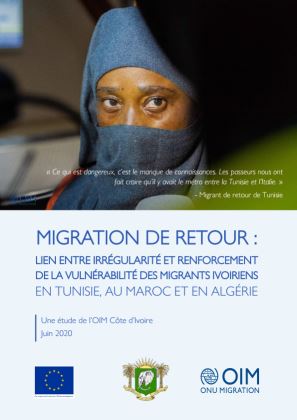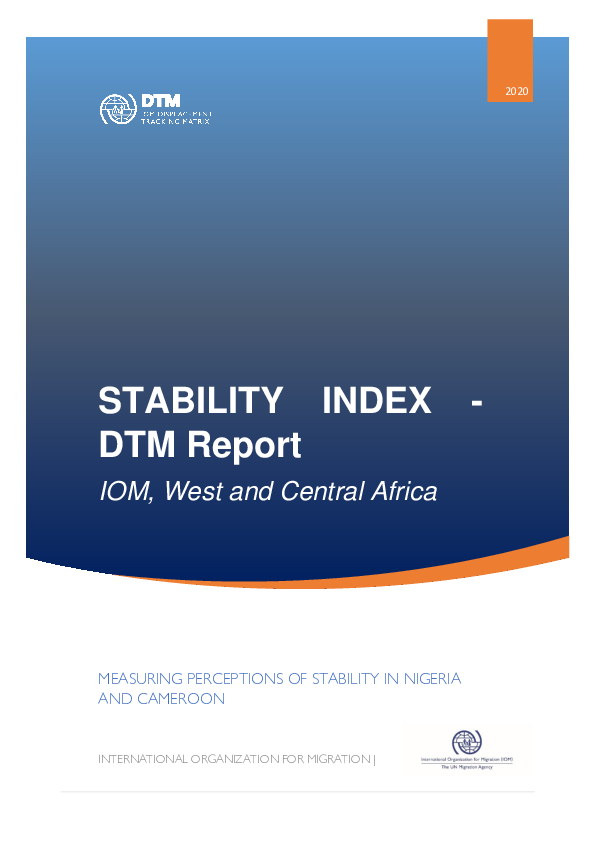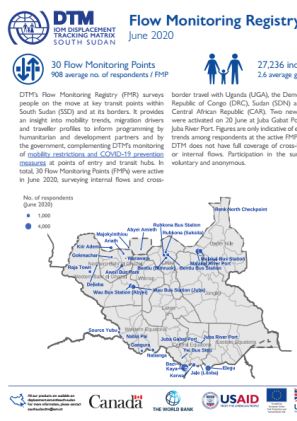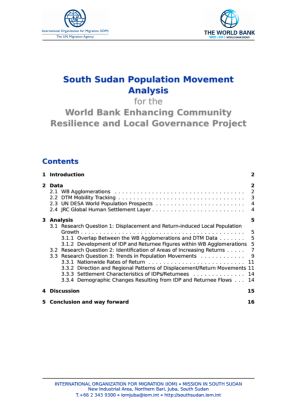-
Countries
-
Data and Analysis
-
Special Focus
-
Crisis Responses
Return migration
The West and Central Africa Mobility Mapping report is a compilation of maps showing various mobility trends and mobility factors for movements to and from the West and central Africa region (forced displacement, transhumance, labour movements, etc.) This work is based on multiple data collection activities implemented by IOM and other actors (UNDESA, Ministries of Interior of various countries) and showcase the complexity of mobility in the region.

Contact
Aude Nanquette, Ananquette@iom.int
Language
French
Location
Côte d’Ivoire
Period Covered
May 01 2017
May 31 2020
Activity
- Other
- Survey
- Flow Monitoring Survey
La Côte d’Ivoire est l’un des principaux pays d’origine pour les migrants qui empruntent l’itinéraire de la Méditerranée centrale avec près de 25 000 arrivées en Italie par la mer depuis 2016.
Parmi les 6 757 migrants ivoiriens assistés dans leur retour volontaire dans le cadre de l’Initiative Conjointe UE-OIM entre Mai 2017 et Mai 2020 : 39% sont rentrés du Niger ; 31% de la Libye, 14% du Maroc et 7% de la Tunisie. La majeure partie des migrants de retour du Niger ont été reconduits à la frontière depuis l’Algérie et les migrants de retour de Libye ont principalement transité par l’Algérie, le Maroc ou la Tunisie.
La Tunisie, le Maroc et l’Algérie sont pour les migrants ivoiriens des pays de première destination (transit), de destination finale ou encore de retour. Ainsi, la grande majorité des personnes rentrées en Côte d’Ivoire avec l’assistance de l’OIM ont transité ou séjourné dans un de ces trois pays, ce qui incite à s’interroger sur l’expérience migratoire des Ivoiriens de retour de la Tunisie, du Maroc et de l’Algérie.
Les données ont été collectées auprès de personnes qui se sont tournées vers l’OIM dans le cadre d’une assistance au retour volontaire du fait de conditions de vie très difficiles dans les pays cités. Des focus groups (FGD) ont été organisés avec des femmes et des hommes de retour d’un de ces trois pays : 6 FGD au total (2 FGD avec des retournés de la Tunisie ; 2 FGD avec des retournés du Maroc et 2 FGD avec des retournés de l’Algérie). Par ailleurs, 315 questionnaires ont été administrés par téléphone afin de saisir l’expérience des interviewés et de mettre en évidence des tendances2 :
- 100 migrants de retour de la Tunisie depuis au moins six mois (dont 50 femmes et 50 hommes) ;
- 100 migrants de retour du Maroc depuis au moins six mois (dont 50 femmes et 50 hommes) ;
- 115 migrants ayant séjourné en Algérie et de retour (de l’Algérie ou du Niger) depuis au moins six mois (dont 25 femmes et 90 hommes3).
L’ensemble des données collectées ont été analysées afin de faire émerger les principales tendances. Les résultats préliminaires de l’étude ont été validés au cours d’un atelier rassemblant des structures gouvernementales et des organisations de la société civile en lien avec la migration.
The DTM Monthly Regional Update contains consolidated summary updates and highlights from DTM field operations. This document covers updates from the regional network of flow monitoring of migrants, as well as the tracking and monitoring of internal displacement in the countries. It is published on a monthly basis and covers the West and Central Africa Region.

Contact
DTM Nigeria, DTMNigeria@iom.int
Language
English
Location
Nigeria
Period Covered
Aug 01 2019
Sep 30 2019
Activity
- Registration
- Biometric Registration
- Mobility Tracking
- Baseline Assessment
A report by IOM’s Displacement Tracking Matrix (DTM) identified 4.2 million displaced individuals in Nigeria, Chad, and Cameroon in 2019. However, as the protracted conflict begins to subside in some regions, there are a growing number of displaced persons returning to their towns and villages of origin. The DTM noted a 77 per cent increase (800,000 individuals) in the number of returnees in 2019 compare those reported in 2016. The total population of returnees represents 41 per cent of the total population affected by displacements in the Lake Chad Basin. This growing trend towards return movements calls for a more thorough investigation to better understand the returnee populations in the regions and communities of origin. It is also highlighting the importance of assessing the return intentions of individuals who are still displaced in order to provide the necessary assistance for the reintegration of those who have already returned to their area of origin, as well as to those who intend to return in the near future.
The stability index identifies ‘pockets of stability’ to target the needs of the large proportion of returnee populations and analyzes which factors are relatively more impactful on the decisions of returnees to remain in place or to move. Furthermore, it is an essential tool in designing assistance for durable solutions as well as a new instrument to inform transition and recovery with appropriate programming priorities.

Contact
DTM Cameroun, DTMCameroon@iom.int
Language
English
Location
Cameroon
Period Covered
Aug 01 2019
Sep 30 2019
Activity
- Mobility Tracking
- Baseline Assessment
A report by IOM’s Displacement Tracking Matrix (DTM) identified 4.2 million displaced individuals in Nigeria, Chad, and Cameroon in 2019. However, as the protracted conflict begins to subside in some regions, there are a growing number of displaced persons returning to their towns and villages of origin. The DTM noted a 77 per cent increase (800,000 individuals) in the number of returnees in 2019 compare those reported in 2016. The total population of returnees represents 41 per cent of the total population affected by displacements in the Lake Chad Basin. This growing trend towards return movements calls for a more thorough investigation to better understand the returnee populations in the regions and communities of origin. It is also highlighting the importance of assessing the return intentions of individuals who are still displaced in order to provide the necessary assistance for the reintegration of those who have already returned to their area of origin, as well as to those who intend to return in the near future.
The stability index identifies ‘pockets of stability’ to target the needs of the large proportion of returnee populations and analyzes which factors are relatively more impactful on the decisions of returnees to remain in place or to move. Furthermore, it is an essential tool in designing assistance for durable solutions as well as a new instrument to inform transition and recovery with appropriate programming priorities.
This report presents the results of the Stability Index data collection activities conducted in Nigeria and Cameroon in August and September 2019.
A report by IOM’s Displacement Tracking Matrix (DTM) identified 4.2 million displaced individuals in Nigeria, Chad, and Cameroon in 2019. However, as the protracted conflict begins to subside in some regions, there are a growing number of displaced persons returning to their towns and villages of origin. The DTM noted a 77 per cent increase (800,000 individuals) in the number of returnees in 2019 compare those reported in 2016. The total population of returnees represents 41 per cent of the total population affected by displacements in the Lake Chad Basin. This growing trend towards return movements calls for a more thorough investigation to better understand the returnee populations in the regions and communities of origin. It is also highlighting the importance of assessing the return intentions of individuals who are still displaced in order to provide the necessary assistance for the reintegration of those who have already returned to their area of origin, as well as to those who intend to return in the near future.
The stability index identifies ‘pockets of stability’ to target the needs of the large proportion of returnee populations and analyzes which factors are relatively more impactful on the decisions of returnees to remain in place or to move. Furthermore, it is an essential tool in designing assistance for durable solutions as well as a new instrument to inform transition and recovery with appropriate programming priorities.
This report presents the results of the Stability Index data collection activities conducted in Nigeria and Cameroon in August and September 2019.

Contact
DTM Iraq, IraqDTM@iom.int
Language
English
Location
Iraq
Period Covered
Jul 01 2020
Jul 31 2020
Activity
- Survey
- Return Intention
- Mobility Tracking
- Baseline Assessment
The Return Index is a tool designed to measure the severity of conditions in locations of return. Data collection for the Return Index Round 9 took place during the months of May and June 2020 across eight governorates, 38 districts and 2,013 locations in Iraq. During Round 9, an additional 163 locations of return were assessed.

Contact
iomphnompenh@iom.int
Language
English
Location
Cambodia
Period Covered
Jun 01 2020
Jun 30 2020
Activity
- Survey
In June 2020, a team of enumerators completed phone-based data collection on international migrants returning home to Cambodia after the outbreak of COVID-19 pandemic and subsequent governmental response measures. The assessment aimed to shed light on the COVID-19 impact on migrant workers, especially related to the ongoing global recession. Correspondingly, survey questions focused on 1) the demographic and socio-economic profile of the returnees, 2) their migration and return experiences and practices, 3) their livelihoods and employment and 4) their economic and social needs and vulnerabilities.
A total of 242 respondents in 5 priority provinces of high returns were interviewed in this assessment.

Contact
DTM South Sudan, SouthSudanDTM@iom.int
Language
English
Location
South Sudan
Period Covered
Jun 01 2020
Jun 30 2020
Activity
- Flow Monitoring
DTM’s Flow Monitoring Registry (FMR) surveys people on the move at key transit points within South Sudan (SSD) and at its borders. It provides an insight into mobility trends, migration drivers and traveller profiles to inform programming by humanitarian and development partners and by the government, complementing DTM’s monitoring of mobility restrictions and COVID-19 prevention measures at points of entry and transit hubs. In total, 30 Flow Monitoring Points (FMPs) were active in June 2020, surveying internal flows and cross-border travel with Uganda (UGA), the Democratic Republic of Congo (DRC), Sudan (SDN) and the Central African Republic (CAR). Two new FMPs were activated on 20 June at Juba Gabat Port and Juba River Port. Figures are only indicative of existing trends among respondents at the active FMPs since DTM does not have full coverage of cross-border or internal flows. Participation in the survey is voluntary and anonymous.
The summary dataset for June 2020 is available here.

Contact
DTM South Sudan, SouthSudanDTM@iom.int
Language
English
Location
South Sudan
Period Covered
Jun 01 2019
Jun 30 2019
Activity
- Mobility Tracking
- Baseline Assessment
The Government of South Sudan requested World Bank support for a project that improves local services, strengthens local governance, and increases social cohesion. Accordingly, the World Bank (WB) created the “Enhancing Community Resilience and Local Governance” project which will focus on addressing basic service delivery needs on the ground, particularly in areas where the displaced have returned. The World Bank approached IOM South Sudan to perform tailored research and analysis that will assist the World Bank task team, host country clients, and implementation partners as they design and prepare the new operation. The research requested includes population movement analysis, which – building on IOM South Sudan’s Displacement Tracking Matrix (DTM) data as well as existing secondary data – addresses the following research questions:
(1) The World Bank has identified 34 agglomerations as large and most rapidly growing population centers in the South Sudan. Using DTM data, the analysis requested shall determine the degree of overlap between these agglomerations and DTM data with regard to the concentration of returnees in the country. It shall thereby assess the extent to which population growth in these areas is attributable to return movements of refugees and IDPs.
(2) The analysis requested shall identify other agglomerations (whether rural or urban) additional to the 34 identified by the World Bank, which show rapid population growth due the inflow of returnees, using DTM and other available data.
(3) The analysis requested shall provide overall trends in population movement over the last 44 months, including: nationwide rates of return; direction and regional patterns of returns; predominant ethnic composition of population flows; demographic changes in key areas of returnee concentrations resulting from these flows; settlement patterns of returning refugees and IDPs.
Pagination
- Previous page
- Page 29
- Next page



